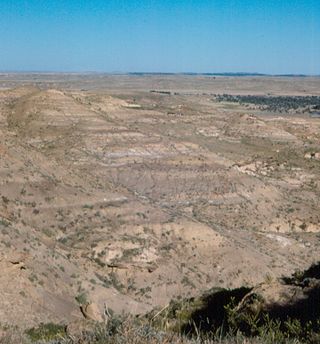
The Lance (Creek) Formation is a division of Late Cretaceous rocks in the western United States. Named after Lance Creek, Wyoming, the microvertebrate fossils and dinosaurs represent important components of the latest Mesozoic vertebrate faunas. The Lance Formation is Late Maastrichtian in age, and shares much fauna with the Hell Creek Formation of Montana and North Dakota, the Frenchman Formation of southwest Saskatchewan, and the lower part of the Scollard Formation of Alberta.

Hagryphus is a monospecific genus of caenagnathid dinosaur from southern Utah that lived during the Late Cretaceous in what is now the Kaiparowits Formation of the Grand Staircase–Escalante National Monument. The type and only species, Hagryphus giganteus, is known only from an incomplete but articulated left manus and the distal portion of the left radius. It was named in 2005 by Lindsay E. Zanno and Scott D. Sampson. Hagryphus has an estimated length of 2.4–3 metres and weight of 50 kilograms.

The Kirtland Formation is a sedimentary geological formation.
Hyposaurus is a genus of extinct marine dyrosaurid crocodyliform. Fossils have been found in Paleocene aged rocks of the Iullemmeden Basin in West Africa, Campanian–Maastrichtian Shendi Formation of Sudan and Maastrichtian through Danian strata in New Jersey, Alabama and South Carolina. Isolated teeth comparable to Hyposaurus have also been found in Thanetian strata of Virginia. It was related to Dyrosaurus. The priority of the species H. rogersii has been debated, however there is no sound basis for the recognition of more than one species from North America. The other North American species are therefore considered nomina vanum.

Bothremydidae is an extinct family of side-necked turtles (Pleurodira) known from the Cretaceous and Cenozoic. They are closely related to Podocnemididae, and are amongst the most widely distributed pleurodire groups, with their fossils having been found in Africa, India, the Middle East, Europe, North America and South America. Bothremydids were aquatic turtles with a high morphological diversity, indicative of generalist, molluscivorous, piscivorous and possibly herbivorous grazing diets, with some probably capable of suction feeding. Unlike modern pleurodires, which are exclusively freshwater, bothremydids inhabited freshwater, marine and coastal environments. Their marine habits allowed bothremydids to disperse across oceanic barriers into Europe and North America during the early Late Cretaceous (Cenomanian). The youngest records of the group are indeterminate remains from Saudi Arabia and Oman, dating to the Miocene.

The Pierre Shale is a geologic formation or series in the Upper Cretaceous which occurs east of the Rocky Mountains in the Great Plains, from Pembina Valley in Canada to New Mexico.
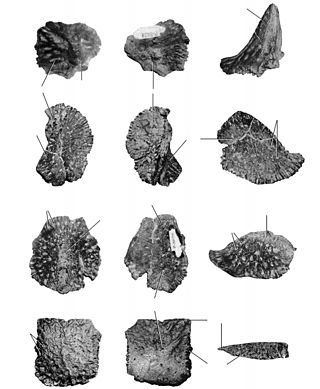
Akanthosuchus is an extinct genus of alligatoroid crocodilian, possibly an alligatorine. Its fossils are found in the Paleocene-age Nacimiento Formation of the San Juan Basin, New Mexico, USA. It is known from a partial skeleton and isolated bony armor. Its armor was distinctive, with spike-shaped and blade-shaped pieces, and it is the only known crocodilian with a combination of both.
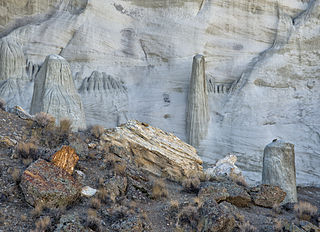
The Wahweap Formation of the Grand Staircase–Escalante National Monument is a geological formation in southern Utah and northern Arizona, around the Lake Powell region, whose strata date back to the Late Cretaceous. Dinosaur remains are among the fossils that have been recovered from the formation.
Batrachosauroides is an extinct genus of prehistoric salamander known from several sites across the United States. The two identified species are Batrachosauroides dissimulans and Batrachosauroides gotoi. A proposed, unidentified third species has been proposed by paleontologist James Gardner based on the discovery of a dental fossil in the Bushy Tailed Blowout area of the Lance Formation fossil grounds, but has not been definitively identified as a new species or as part of either of the two identified species.
Eoscapherpeton is an extinct genus of giant salamander, known from the Late Cretaceous of Central Asia. Fossils have been found in the Cenomanian aged Khodzhakul Formation and Dzharakuduk Formation, Turonian aged Bissekty Formation and the Coniacian-Santonian aged Aitym Formation of Uzbekistan, the Santonian aged Yalovach Formation of Tajikistan, and the Santonian-lower Campanian aged Bostobe Formation and Campanian aged Darbasa Formation of Kazakhstan.
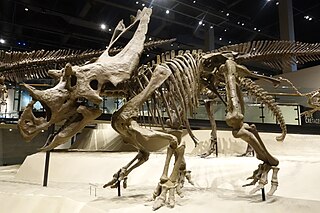
Utahceratops is an extinct genus of ceratopsian dinosaur that lived approximately 76.4~75.5 million years ago during the Late Cretaceous period in what is now Utah. Utahceratops was a large-sized, robustly-built, ground-dwelling, quadrupedal herbivore, that could grow up to an estimated 4.5–5 m (15–16 ft) long.

During most of the Late Cretaceous the eastern half of North America formed Appalachia, an island land mass separated from Laramidia to the west by the Western Interior Seaway. This seaway had split North America into two massive landmasses due to a multitude of factors such as tectonism and sea-level fluctuations for nearly 40 million years. The seaway eventually expanded, divided across the Dakotas, and by the end of the Cretaceous, it retreated towards the Gulf of Mexico and the Hudson Bay. This left the island masses joined in the continent of North America as the Rocky Mountains rose. From the Cenomanian to the end of the Campanian ages of the Late Cretaceous, Appalachia was separated from the rest of North America. As the Western Interior Seaway retreated in the Maastrichtian, Laramidia and Appalachia eventually connected. Because of this, its fauna was isolated, and developed very differently from the tyrannosaur, ceratopsian, hadrosaurid, pachycephalosaur and ankylosaurid dominated fauna of the western part of North America, known as "Laramidia".

Teratophoneus is a genus of tyrannosaurine theropod dinosaur that lived during the late Campanian age of the Late Cretaceous period, in what is now Utah. It contains a single known species, T. curriei. It is known from an incomplete skull and postcranial skeleton recovered from the Kaiparowits Formation and was specifically named T. curriei in honor of famed paleontologist Philip J. Currie.
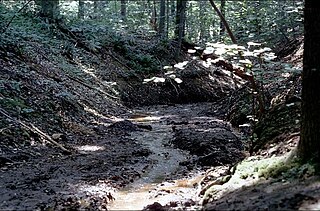
The Ellisdale Fossil Site is located near Ellisdale in the valley of the Crosswicks Creek, in Monmouth County, New Jersey, United States. The site has produced the largest and most diverse fauna of Late Cretaceous terrestrial animals from eastern North America, including the type specimens of the teiid lizard Prototeius stageri and the batrachosauroidid salamander Parrisia neocesariensis. The site occurs within the basal portion of the Marshalltown Formation, and dates from the Campanian Stage of the Late Cretaceous. The site is classified as a Konzentrat-Lagerstätten resulting from a prehistoric coastal storm.
Talos is an extinct genus of carnivorous bird-like theropod dinosaur, an advanced troodontid which lived during the late Cretaceous period in the geographic area that is now Utah, United States.
The Marlbrook Marl is a geologic formation in Arkansas. It preserves fossils dating back to the Cretaceous period.

Batrachosauroididae is an extinct family of prehistoric salamanders with holarctic distribution. They were paedomorphic and presumably aquatic. They are possibly the sister taxon of Proteidae, an extant family of aquatic salamanders. They are definitively known from the Late Cretaceous to Miocene of North America and Europe. Remains from the earliest Cretaceous (Berriasian) Lulworth Formation of England have tenatively been attributed to this family.
Protalphadon is a genus of small mammal from the late Cretaceous. Its fossils are found in Utah, Montana, New Jersey, South Dakota, Wyoming and Colorado. Originally the genus was assigned to Alphadon.












